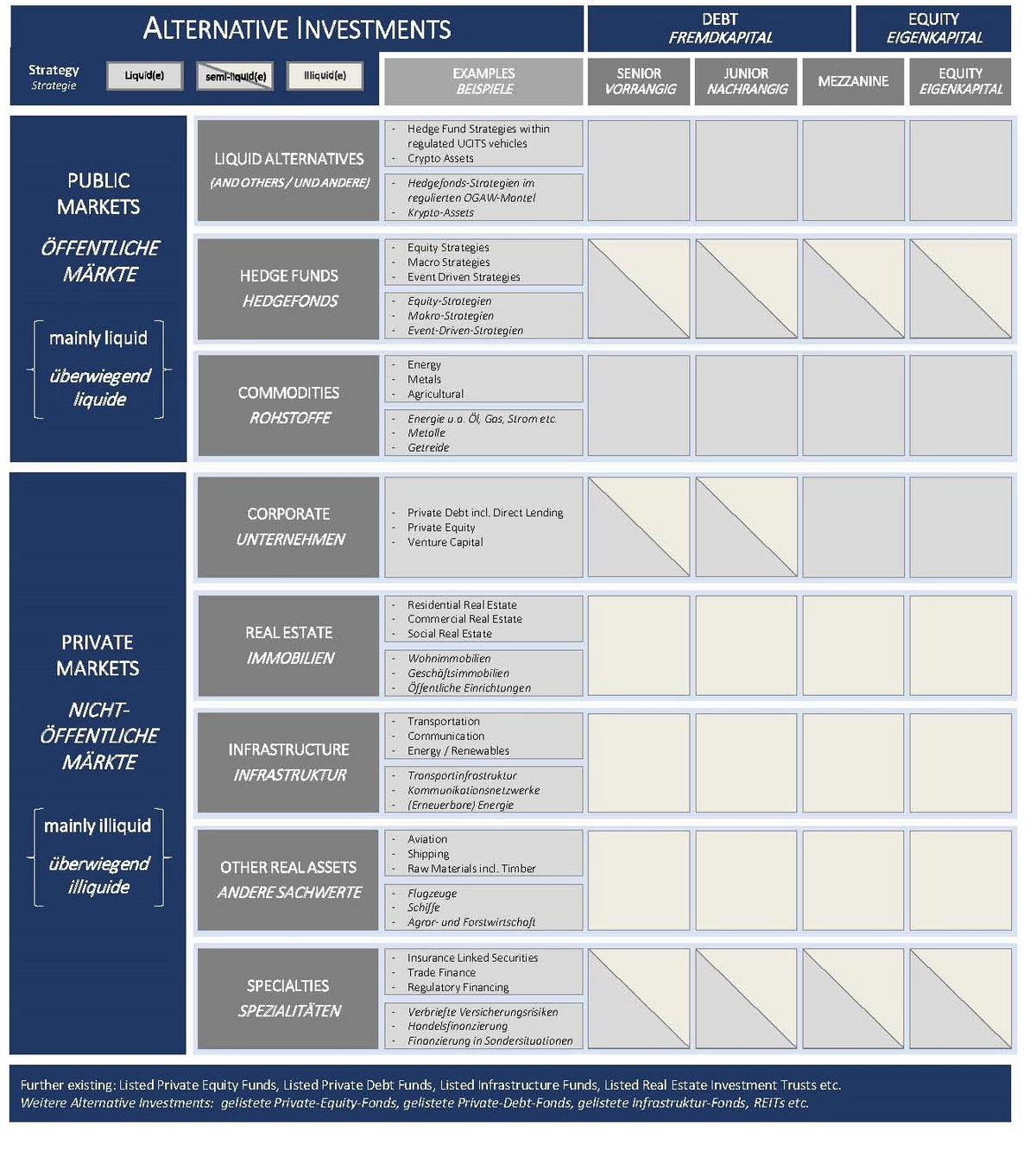Bundesverband Alternative Investments e.V. (BAI)
The term is often associated with infrastructure and private equity, even though the field of AI extends to private debt, real estate, hedge funds, or commodities as well as further specialities such as aviation and shipping, or crypto assets. Since no generally valid definition exists, one finds various interpretations. BAI understands Alternative Investments as investments in non-traditional asset classes (other than shares and bonds) or the investment in these asset classes with the help of more complex, non-traditional strategies.
Alternative Investments are becoming an indispensable component of capital investment, especially with institutional investors such as insurance companies or pension funds, as well as HNWI. A clearly distinctive classification of the individual classes is often difficult. Hedge funds, for example, can be categorized according to asset classes and strategies, but their common denominator is often the nature or timing of the investment. What unites the asset classes and strategies is the fact that they contribute to a significant improvement in the risk / return ratio with appropriate portfolio allocation. In addition to the diversification effect, there are other features that characterise Alternative Investments:
- above-average return potential,
- use of levers, derivatives or short sales,
- returns often not normally distributed,
- complex performance and risk measurement,
- possibly lower liquidity,
- possibly lower transparency.
Strategies or concepts that bring stability to the portfolio through long-term investment in non-listed assets can make a significant value contribution to increasing the efficiency or restructuring of companies (private equity), as well as to the energy turnaround or sustainable supply (e.g. infrastructure). Investments in agricultural land, real estate, real assets such as aircraft and ships or commodities are regularly allocated to Alternative Investments. Recently, crypto assets have also become increasingly important. Alternative Investments are also characterised by the variety of structuring and access options: in addition to direct and
indirect investments (e.g. via funds or derivatives), there is a choice between equity investments on the one hand and debt investments (e.g. loans) on the other. The provision of loans by non-banks (e.g. through credit funds) without the involvement of the capital market is also known as private debt.

The financial crisis and the market environment that has prevailed since then have shown that pure portfolio diversification via shares and bonds, which is additionally limited to buying, holding and later selling (buy-and-hold strategy), is not always expedient. Moreover, the low interest rate environment that has now been persisting for several years is putting considerable pressure on portfolio returns. As a result, institutional investors are increasingly havi ng problems meeting their obligations in the form of guaranteed interest rates. Various strategies from the investment spectrum of Alternative Investments are available to counteract
this. As the international financial markets become more closely intertwined, correlations between them are increasing. As a result, geographical diversification across different markets – and to some extent across different asset classes – no longer has the desired risk-reducing effect. Correlation is a variable that shows the statistical relationship between two time series (e.g. returns). In portfolio construction, diversification effects can be achieved by combining weakly correlated investments. The overall risk of a portfolio is lower if its components are only weakly correlated. Consequently, portfolio composition requires the selection of
assets for which such a correlation does not occur or only occurs to a limited extent. It is precisely for this purpose that Alternative Investments are used in modern portfolio allocation. The importance of Alternative Investments will continue to increase: Private debt, private equity and infrastructure in particular will increasingly become an integral part of portfolio structuring. This is partly due to the macroeconomic environment, but also reflects a changing approach to and active management of risks, all of which can be better managed with the expertise that has been built up in the investment industry.

